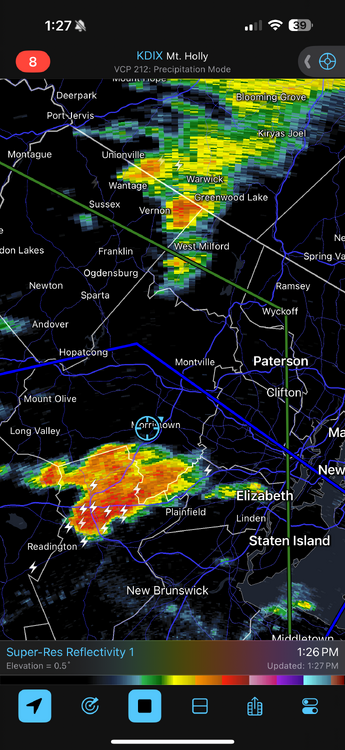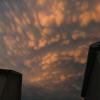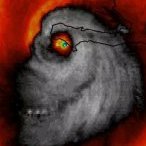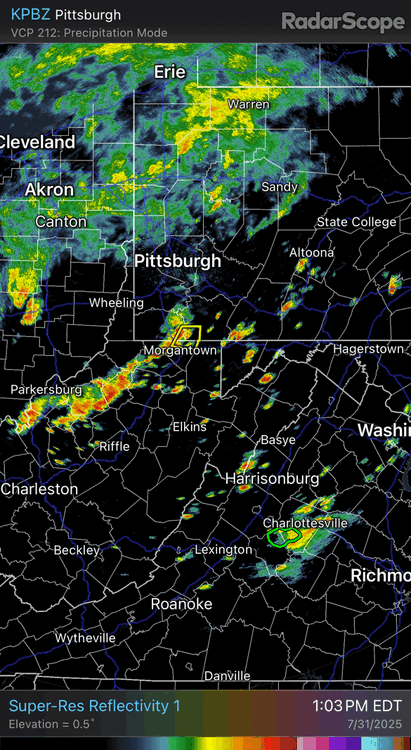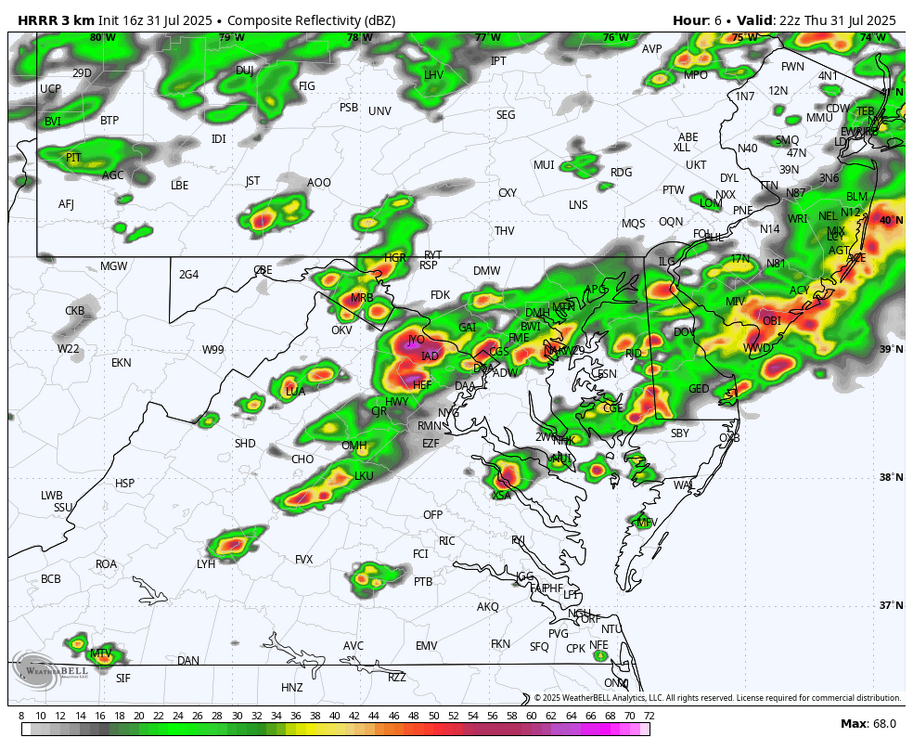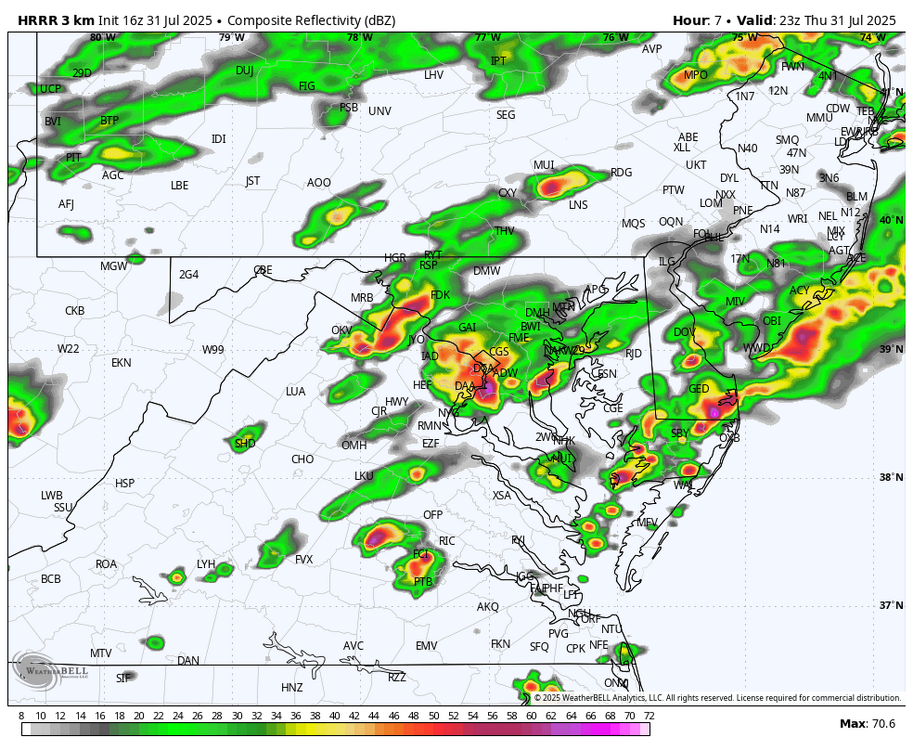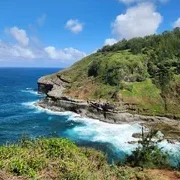All Activity
- Past hour
-
Watch up till 8pm
- 1,337 replies
-
- severe
- thunderstorms
-
(and 2 more)
Tagged with:
-
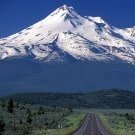
Central PA Summer 2025
Mount Joy Snowman replied to Voyager's topic in Upstate New York/Pennsylvania
Yeah I'm right in the thick of it and the dreaded back-building keeps happening every time I think the back edge is near. Over an inch and a half now. Developing.... -
brief pop up shower here with more all around
-
Several factors have me betting the under today. This is just a gut instinct. Storms just fired a bit to the east of the metros now moving away - leaving cloud cover. To the west I see activity but it would really need to generate. Id be more excited if we had bright sun at 1:25 pm. Not to be a Debbie but I am taking the under today for the widespread flooding. I have not looked at a model sounding - I've just lived here most of my life. Disclaimer: I do not have a red met tag.
- 1,337 replies
-
- severe
- thunderstorms
-
(and 2 more)
Tagged with:
-
-
-
The NWS just posted instructions on how to bake a lasagna in your mailbox
-
July 2025 Obs/Disco ... possible historic month for heat
Hailstoned replied to Typhoon Tip's topic in New England
That's a queer choir you're preaching to. -

July 2025 Obs/Disco ... possible historic month for heat
weatherwiz replied to Typhoon Tip's topic in New England
I'd watch the potential for a tornado or two across the Connecticut shoreline and especially Long Island. -
Severe Thunderstorm Watch up east of the mountains.
-
And so it begins....Flood Warnings have been issued.
-

E PA/NJ/DE Summer 2025 Obs/Discussion
RedSky replied to Hurricane Agnes's topic in Philadelphia Region
Reds touching me on radar I have drizzle -
July 2025 Discussion-OBS - seasonable summer variability
TheClimateChanger replied to wdrag's topic in New York City Metro
I would say it is. I asked xAI's Grok to estimate what the climate of New York City would have looked like at the height of the last glacial maximum. I think most here would agree that this is MILES better than the current climate. Month Estimated Mean Temperature (°C) Estimated Mean Temperature (°F) January -15 to -10°C 5 to 14°F February -14 to -9°C 7 to 16°F March -10 to -5°C 14 to 23°F April -3 to 2°C 27 to 36°F May 3 to 8°C 37 to 46°F June 10 to 15°C 50 to 59°F July 12 to 17°C 54 to 63°F August 10 to 15°C 50 to 59°F September 5 to 10°C 41 to 50°F October 0 to 5°C 32 to 41°F November -5 to 0°C 23 to 32°F December -12 to -7°C 10 to 19°F Winter (Dec–Feb): Very cold, with means likely between -15°C and -7°C (5–19°F), similar to modern subarctic or high-latitude tundra climates. Frequent snow was probable, but low precipitation meant less accumulation than in modern snowy regions like upstate New York. Summer (Jun–Aug): Short and cool, with July means likely 12–17°C (54–63°F), resembling modern high-latitude coastal areas (e.g., parts of Iceland or northern Canada). Proximity to the ice sheet and cold Atlantic Ocean currents kept summers chilly. Precipitation and Snow: The climate was drier than today due to cold air holding less moisture. Snow was common in winter, but total accumulation was likely moderate, with a tundra-like landscape. Permafrost was widespread, affecting soil and vegetation. Ice Sheet Influence: The Laurentide Ice Sheet, terminating near Long Island, would have cooled NYC via cold air drainage and albedo effects. Cold ocean currents along the Atlantic coast further suppressed temperatures. Variability: Daily and annual variability was likely high, with cold snaps in winter and occasional warm days in summer. Strong winds from the ice sheet (katabatic winds) could have made conditions feel even colder. -

July 2025 Discussion-OBS - seasonable summer variability
RedSky replied to wdrag's topic in New York City Metro
Eh tobacco smoking takes 5-10 years and often decades off peoples life -

July 2025 Discussion-OBS - seasonable summer variability
Picard replied to wdrag's topic in New York City Metro
I'm OK with a couple of degrees. Things could adapt, and there are indeed benefits for some. Beyond that though, I think it introduces more problems, some of which are already unfolding like melting glaciers, rising seas, and a positive feedback loop that keeps it all going. Regarding your comment on stopping driving cars - not going to happen. I am waiting for a day when I could buy a relatively inexpensive independently duel powered vehicle, and I'm in. In other words, the gasoline engine is ready to fire up if I run out of battery. And eventually, I think, among other problems, we're going to be running into problems of sourcing EV batteries, and disposal of spent batteries. Cars by themselves are only part of the issue. It's also the sheer demand of goods and services in this country, as well as our throw away culture. By a TV, don't like it in a year, or want a better one, or some minor glitch prevents it from working properly? No problem, just toss it and by a new one. -
July 2025 Discussion-OBS - seasonable summer variability
TheClimateChanger replied to wdrag's topic in New York City Metro
I don't think one night in the upper 30s would do much harm to corn/maize. Obviously, if it was consistently cold (and/or moist) that would affect growth. Consistently warm overnight temperatures are a bigger concern because the plant can respire through the night and burn stored energy faster than it can be replenished. Corn is native to higher latitudes in Mexico. It does best with overnight lows from in the 50s/low 60s. -

July 2025 Discussion-OBS - seasonable summer variability
IrishRob17 replied to wdrag's topic in New York City Metro
What a difference up here from yesterday, currently 66/63 and breezy as more rain moves in, I have to admit there is an early fall feel out there for now. -

E PA/NJ/DE Summer 2025 Obs/Discussion
RedSky replied to Hurricane Agnes's topic in Philadelphia Region
It's managing to squeeze by a mile to my south


